Lothian Regional Transport
 |
|

|
|
| Slogan | Your locally owned buses ..way ahead in Edinburgh ..way ahead in Midlothian |
|---|---|
| Parent |
Transport for Edinburgh (91%) East Lothian Council Midlothian Council West Lothian Council |
| Founded | 1919 |
| Headquarters | Edinburgh |
| Service area | Edinburgh East Lothian Midlothian |
| Service type | Bus services Open top bus tours |
| Alliance | Edinburgh Trams |
| Routes | 56 (daytime) / 12 (night buses) 9 (East Coast Buses) 1 (Lothian Country) |
| Depots |
Longstone Annandale Street Marine Musselburgh North Berwick |
| Fleet | 721 (December 2014) |
| Annual ridership | 120 million (December 2016) |
| Website | www |
Lothian Buses is the largest municipal bus company in the United Kingdom. The City of Edinburgh Council through Transport for Edinburgh owns 91%, with the remainder being owned by the East Lothian, Midlothian and West Lothian Councils. Despite West Lothian Council having a shareholding, Lothian Buses operates no services in the region, with most provided by First Scotland East.
Lothian Buses operates the majority of bus services in Edinburgh, extending to outlying suburbs, towns and villages within Edinburgh, East Lothian and Midlothian. The company also operates several limited stop express routes, three Edinburgh Airport services (Airlink 100 together with Skylink 200 and 300), park & ride services and a night bus network as well as several tourist services.
The company operates three travel shops in Edinburgh city centre, and operates buses from five depot locations; Annandale Street, Longstone and Marine all within the city of Edinburgh and two within East Lothian, North Berwick and Musselburgh. The company also maintains a driver training school and an engineering depot at Seafield.
The company can trace its history back to the Edinburgh Street Tramways Company of 1871, also involving at various times the tramway companies of Leith, Musselburgh and Edinburgh North. The City Council (Edinburgh Corporation Tramways Department) took over operation of the tramways in 1919, at which time most of the system was cable operated. Electrification of the tram network was completed in 1923, but the first motor buses had arrived in 1919.
...
Wikipedia
